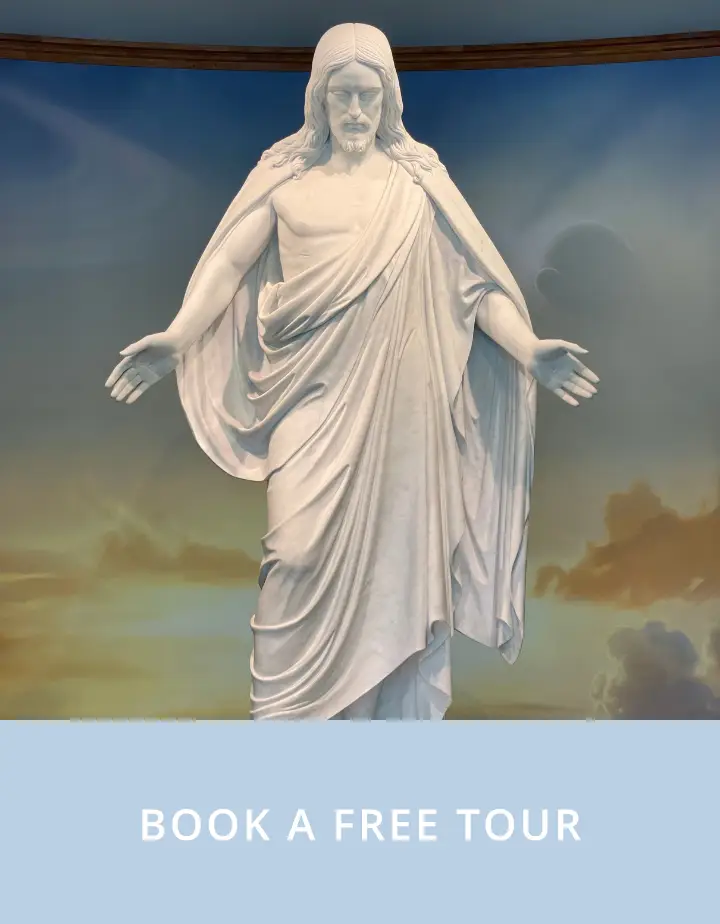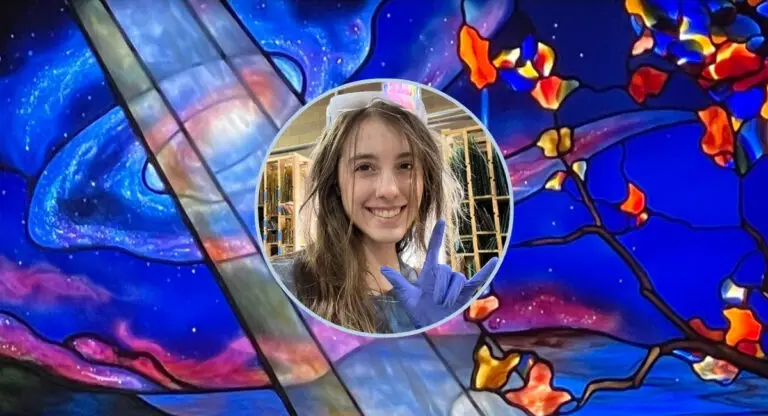Introduction
Lilly Gaskin, a sophomore at Brigham Young University, has worked for Holdman Studios, a stained glass company based in Lehi, Utah, for almost two years. Lilly’s help with the Believe in Him stained glass window helped shape it into what is today: a masterpiece of light and brilliantly colored glass centered on the life and teachings of the Savior, Jesus Christ. Her artistic voice was expressed throughout the assembly and engraving process and through the Believe in Him app, an AR app used to interact directly with the exhibit, featuring Lilly’s voice talent and written work.
Creating something out of stained glass is a laborious task, from idea conception to site installment. Lilly’s job was to cut, grind out, and wrap glass pieces in copper foil before soldering pieces together with molten lead and a soldering iron. The process, much like spiritual progression, requires time, attention to detail, and commitment.
Before Lilly was able to put her cutting and grinding tools to work, however, each piece of glass had to be hand-picked for the right color and pattern. “The glass-picking process was super labor intensive, super hour intensive,” Lilly explained. “We have giant shelves of glass. The people in the design room would sometimes pull out this old, dusty, probably decades-old piece of glass and say: ‘This is your time to shine,’ and they would use it for one piece, maybe two pieces, and back on the shelf it would go.”
A few different methods are employed to cut stained glass, some of which were used millennia ago and are still utilized today, while others are more modern strategies meant to streamline the process. What are they, and what did Holdman Studios use to cut the glass?
“We use [a] water jet,” Lilly explained. “Imagine a laser, but instead of this beam of energy, it’s a beam of water. A really, really, highly pressurized jet of water, and it goes right through the glass. I’ve seen it go through six inches of solid rock…. It cuts the glass perfectly.”
However, using the water jet to cut every piece of glass becomes inefficient, especially because most pieces are unique, and the water jet excels at cutting out duplicate pieces with speed and efficiency.
In those moments, “it’s much easier for us to cut it by hand.” Lilly explained. “To do that, we use glass cutting runners…. Essentially, it’s like a little pencil, and on the end of this pencil is a little rotating wheel. And this wheel is not sharp, per se, but it does score the glass in a line [leaving] a little white line where it scores it. If you tap on that line where the glass has been weakened and scored, it will break on that line. Hopefully.”
Tapping on the weakened, scored glass is the technique that has been used for generations by glassmakers. “That’s pretty much been the method forever and ever, with varying iterations on these tools,” Lilly emphasized. “But that’s how we cut it by hand.”
These iterations have changed the glass-making process with water jet technology. Truly, water is a force of nature, especially when a pressurized stream of it can cut through six inches of solid rock, let alone glass! Lilly did mention, however, that the nature of Believe in Him required a good majority of the smaller pieces to be cut by hand to save time rather than upload a file into the water jet machine and secure the glass below the cutter.
How do you assemble the glass after it is cut?
Lilly responded that each piece of glass needs to be lined with copper foil before it can be soldered together.
But what is copper foiling, what is that process like, and why do stained glass artists need to do it?
Before the pieces of glass can be stitched together with lead to fill the cracks between each shard, each piece has to be lined with copper foil. “The lead does not stick to glass, but it does stick to copper foil…. Because this little metal tape is adhesive on one side, we wrap every piece all along the edge in that copper foil, and then when we fit them together, the solder can stick to the copper lines surrounding each piece.” Flux is also added around the copper foil “as a primer to get the solder on.”
How long does the process of adding the copper foil take?
“Hours. Hours.” Lilly emphatically repeated during the interview. “Copper foiling was the longest part of the process, besides choosing and cutting the glass. It would take ten of us around the table… going at it for at least three to five work days just to get one panel all copper-foiled. I was heavily involved in that, just like everyone else.”
Lilly continued to say that the workshop tables were not large enough to fit the stained glass, despite being “six to eight feet long,” so they had to expand them to fit one pane. “It was insane. We were climbing on tables…. I don’t know how we did some of this,” Lilly laughed. “We’re very ambitious.”
After the glass is cut, lined in copper foil, and pieced together with lead, it still needs to be thoroughly cleaned and placed between two sheets of tempered glass.
This tempered glass is meant to keep it safe, and Lilly compared the transparent, tough glass to the strength of a car windshield. “Once it’s insulated,” she began. “There’s no going back. There can’t be a spot of dust on that window. Building the window, yes, that took forever, but cleaning? Cleaning almost took as long as a lot of the other processes to make it come to life.”
What’s your favorite object or scene in the stained glass display?
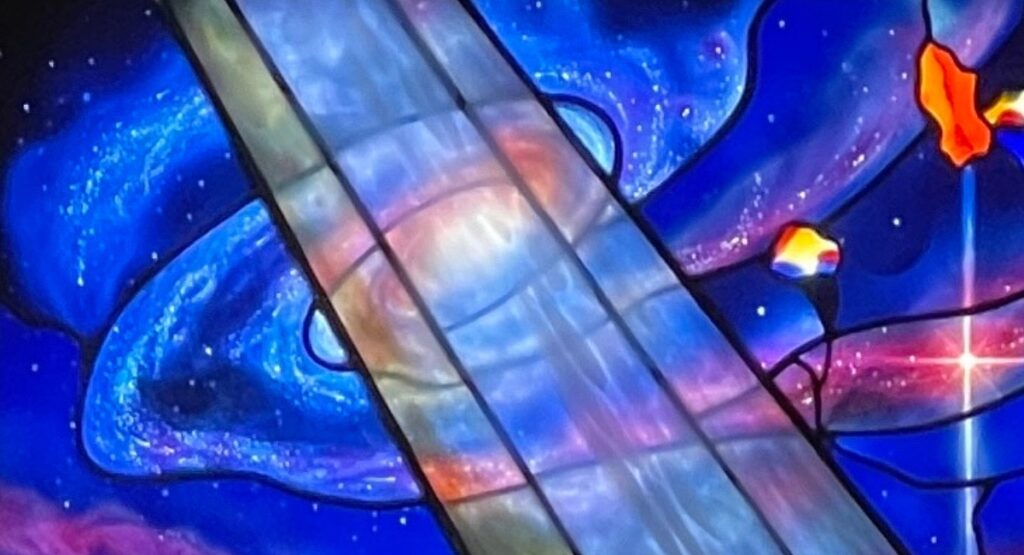
“I believe it’s the leftmost panel… there’s a galaxy. I etched some of the stars into those pieces of glass. I got a drill bit and drilled a little divot into the glass so the light could shine through better. It’s not a hole in the glass, but it’s super close. It makes it super thin and fine so it looks like stars when the light shines through it…. And I just think it turned out so beautifully.”
Lilly’s work on the stars is astounding. Continuing on, she talked about how the white beam of light depicted in glass as it erupts from the spiral galaxy was made by stacking multiple pieces of glass on top of each other and firing them. This process creates layers in the glass beyond what one piece can do on its own and fuses them to create incredible waves of texture. Similar to what Heavenly Father can do in our lives, as we fuse our will with His, we become “redeemed of God” and “new creatures” (Mosiah 27:25-27).
Any interesting stories from the creation of the glass?
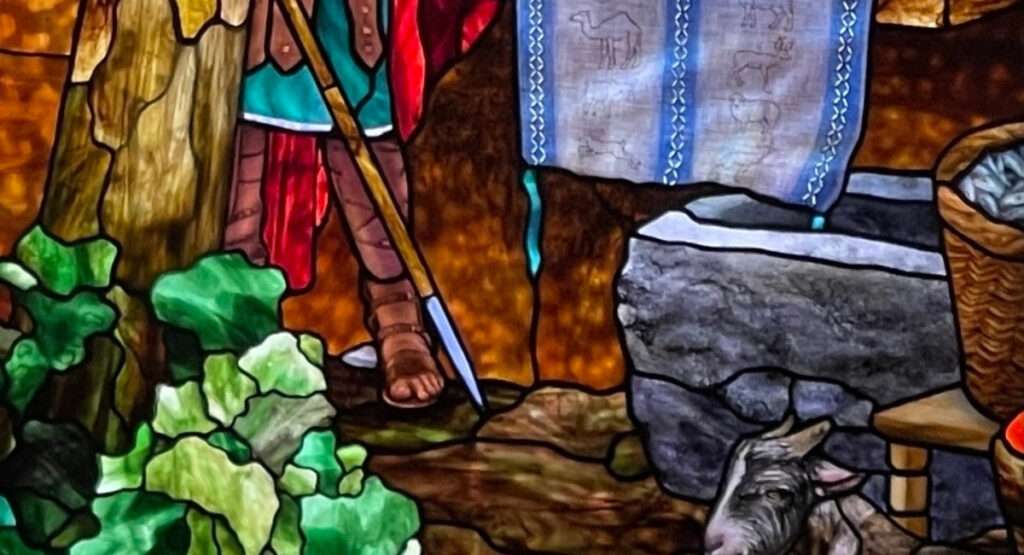
“There’s a Roman centurion… he’s on the left by the woman making the red garments white as snow…. His foot broke when we were putting it all together. That piece is painted…. Painted pieces are not pieces you want to break. They take forever to make, [and] they’re super labor intensive…. We showed it to them, and they said, ‘Well, that guy’s getting a sandal now,’ and so we just copper-foiled the two separate pieces and put a solder line over it.”
A delicate medium such as stained glass means breaks are bound to happen. The centurion’s foot had a weak point but through a refining process, “weak things become strong” (Ether 12:27). When we feel broken, the Savior is eager, willing, and able to heal us (3 Nephi 9:13-15).
I’ve heard there are hidden, real objects soldered into the glass. What are they, and where are they?
“I believe it’s on one of the rightmost panels, there is a vial of tears soldered into the window.”
Lilly wasn’t sure about where the tears came from or why the vial was significant, but was deeply impressed by it and was thoroughly cautioned about how fragile it was during the soldering process.
“I remember them bringing that out and everyone being like, ‘Do not touch it, do not breathe on it wrong, we cannot break this piece. We’ve got to solder it in perfectly. We are not getting our hands on another one of these.’ I think that’s one of the coolest objects in this window that aren’t glass. It’s beautiful. You’ve got to look for it.”
Lilly also mentioned that beyond the widow’s mite hidden in the old woman’s staff, there are actual Roman coins and frankincense soldered into the glass.
What are your favorite symbols in Believe in Him?
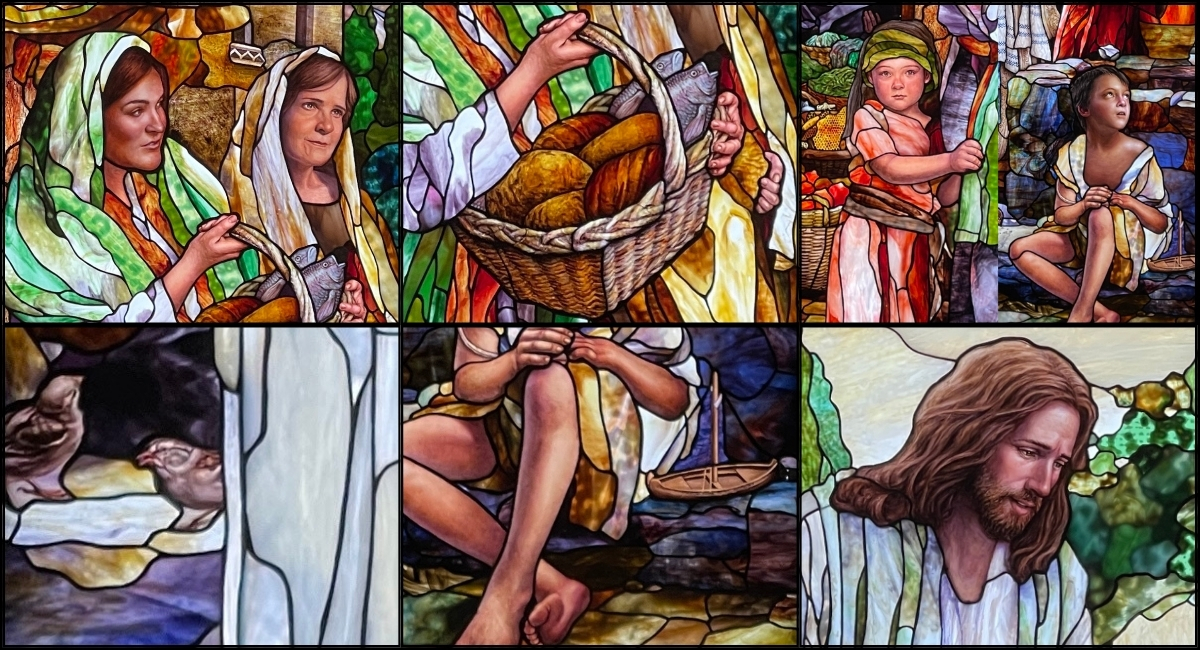
“Every parable you could possibly think of in the Old and New Testament [is] there,” Lilly said. “There are parables upon parables in this.”
- Mary and Martha
- Paying attention to things that are important and right in front of you, and maintaining your relationship with a loving Father in Heaven (Luke 10:38-42).
- Five Loaves and Two Fishes
- Christ feeding the 5,000 (John 6:5-14).
- Christ Loves All of His Children
- Ressurected daughter of Jarius and little boy sitting next to the well representing the little children coming unto Christ and His love for them (Mark 5:38-43, Mark 10:14, 3 Nephi 17:21).
- Sparrows
- “He feeds the birds in the sky. If he cares so much about these sparrows, how much will he care for you? I really like that,” Lilly said. (See Luke 12:6-7).
- Toy Boat
- Christ walked on water and stretched forth His hand to save Peter (Matt 14:22-33).
- Christ as the vocal point
- “If you look at the visual lines, the perspective where people are looking, it all is centered on Christ, and that was so intentional. The rocks on the ground lead to Christ, the birds lead to Christ, everything does. It all brings your attention back to him in a very visually astounding way.”
What did you do to help with the app: “Believe in Him?”
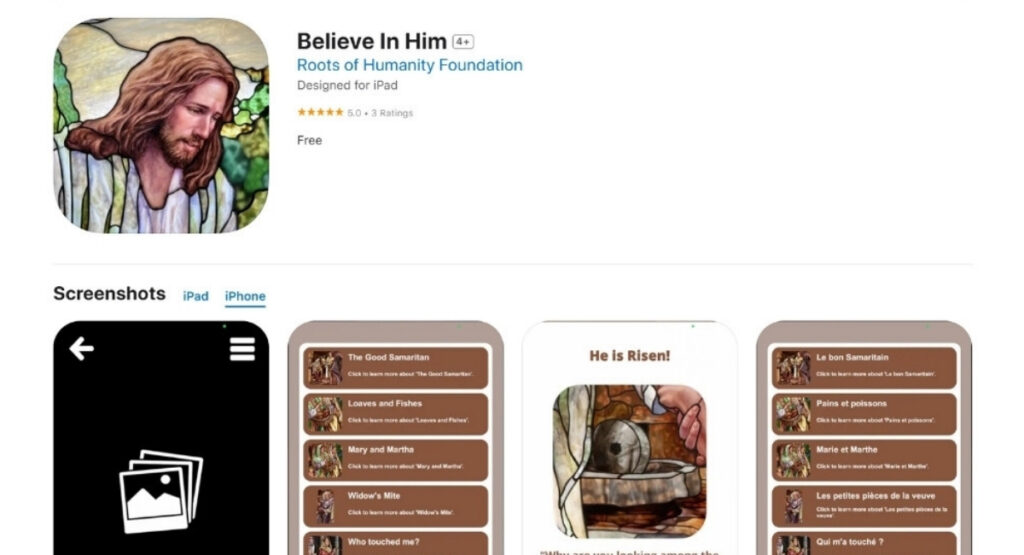
“I wrote all the narrations. [I] had some help from my dad because he was intrinsically involved [as] the editor.” Lilly also described that she did all of the female narration and that her “dad did the male voices.” Lilly’s dad, James Gaskin, is an IS professor at BYU.
For the written content and narration, Lilly said: “I wanted to use keywords from the scriptures that people would recognize so they would be able to tie the narration back to scripture and back to those sources…. That connection… acts as a conduit for the Spirit to be in the narrations.”
Lilly’s focus on the scriptures is both visually and audibly evident through the “Believe in Him” app. By scanning the exhibit in front of you, the figures in the display move in augmented reality on your smartphone, and when tapped, the narrations Lilly wrote and recorded with her dad play. Make sure to use headphones while in the Visitors’ Center to maintain the reflective atmosphere during your visit!
“I also consulted a lot of the Come Unto Me book,” Lilly replied when asked about what resources she used for the app’s content beyond the scriptures. One of the resources she used was a used a book written by Gayle Holdman and a handful of BYU religion professors, including Brad Wilcox, previous first counselor in the Young Men General Presidency. This book describes the creation and symbolism present in the original display Believe in Him was based on. The original, Come Unto Me, is on display in the Rome Italy Temple Visitors’ Center and shares the five inner panels of Believe in Him, with the latter including four additional panels than the original.
“Since a lot was the same [for] both Come Unto Me and Believe in Him for those five central panels, that was a great place to source things,” Lilly said. “That book [Come Unto Me] has really long, detailed descriptions, and so I was able to take that, take notes, [and] try to condense that information to a few short sentences per narration…. There’s so much depth, but I had to do what I could with a 30-second audio clip…. We had to make sure that people of all ages could understand what was going on…. I tried to be as clear as possible while also retaining that formal language.”
What are you working on now for Holdman Studios?

Beyond temple and residential work, Lilly spoke about how Holdman Studios is building the windows for a to-be-built spiral structure with walls made entirely of stained glass. This project, known as the Sphere of Light, will tell the story of humanity as it swirls skyward.
To learn more about the Sphere of Light, please visit Roots of Humanity’s website.
A Retrospective in Stained Glass
“Never let it be said that God does not exist,” Lilly Gaskin submitted near the end of the interview. Lilly’s words echo the words of the prophet, Alma the Younger, in the Book of Mormon.
“But Alma said unto him: Thou hast had signs enough; will ye tempt your God? Will ye say, Show unto me a sign, when ye have the testimony of all these thy brethren, and also all the holy prophets? The scriptures are laid before thee, yea, and all things denote there is a God; yea, even the earth, and all things that are upon the face of it, yea, and its motion, yea, and also all the planets which move in their regular form do witness that there is a Supreme Creator” (Alma 30:44).
Lilly’s work with Holdman Studios and the Roots of Humanity Foundation, from the star-etched galaxy to the fixed foot of a Roman soldier to countless other details, has been essential for both teams and her own spiritual growth of becoming more like the Savior.

Lilly expressed gratitude multiple times during the interview that her work life and religious life were intrinsically connected. “I feel doubly productive when I’m at work and when I’m writing because I know that that glass is going to stand for centuries. Glass does not just wear away. It will stay forever…. That’s the goal. Knowing it’s for the Lord and for His work ensures that what I do means something.”
Feel the peace of the Savior, Jesus Christ, as you learn more about Him at the Washington DC Temple Visitors’ Center with this stained glass masterpiece highlighting His matchless life and mortal ministry. To learn more about the glass to prepare for your visit, take a look at more of the symbolism behind Believe in Him HERE.


